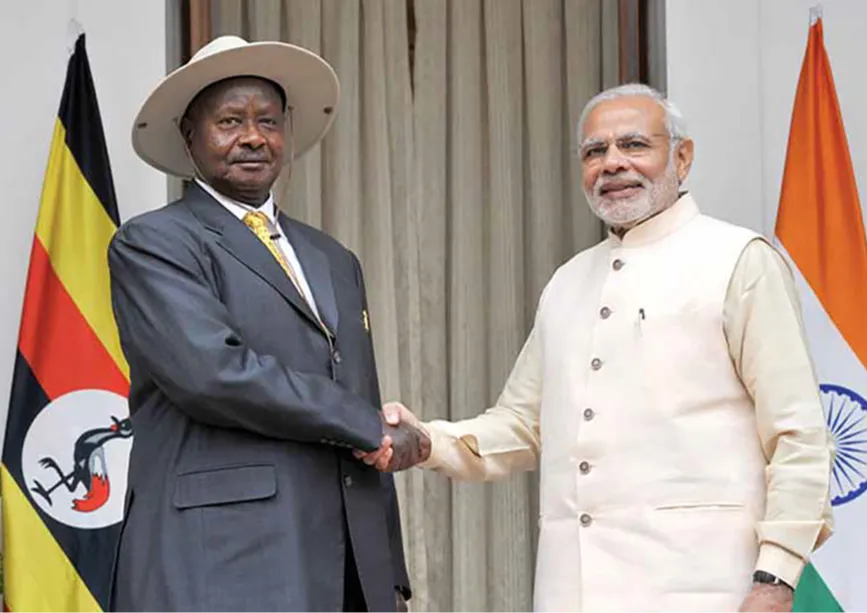
The ongoing Non-Aligned Movement (NAM) Presidency of Uganda underlines India’s diplomatic quandary about the morality of its engagement with Uganda. Following severe anti-LGBTQ legislation and multiple accusations related to human rights violations, which include widespread kidnapping and murder of Opposition supporters, and the arrest of principle Opposition leader Robert Kyagulanyi Ssentamu, Uganda’s relationship with the United States (US) plummeted. To recall, in May 2023, Uganda enacted its contentious Anti-Homosexuality Act, which carries a life sentence or the death penalty for homosexuality. As a measure of punishment, since 1 January 1 2024, the US has suspended Uganda from the African Growth and Opportunity Act (AGOA). AGOA is a preferential trade arrangement that allows member countries duty-free access to the US market for around 6,000 products.
Clearly, the US decision created a ripple effect on Uganda’s economy by freezing its new lending by the World Bank and deterring many foreign direct investments from the West. As a countermeasure, the Ugandan government was desperately seeking a platform to raise its voice. And Uganda got one such opportunity when it successfully hosted the 19th NAM Summit in Kampala from 15 January 15 2024 onwards. The event was indeed an important milestone for the Ugandan President, both diplomatically and politically. In his speech, he pledged to realign the country’s foreign policy to emphasise greater cooperation amongst the Global South.
The Ugandan government is also enthusiastically courting other regional powers, such as China, Russia, Turkey and Iran, each of which has its own vested regional interests.
The presence of Indian External Affairs Minister Dr. S. Jaishankar during the event has indeed been interpreted as India’s endorsement of Uganda’s NAM Presidency. As a matter of fact, to help Uganda in hosting the Summits, India donated to the government of Uganda 10 executive buses, five ambulances, 10 tractors, 2,664 flags and flag poles prior to the event. While multiple Western countries are closing their doors, Uganda expects its historic relationship with India to come to its rescue in countering the West’s effort to diplomatically isolate the country.
However, the Ugandan government is also enthusiastically courting other regional powers, such as China, Russia, Turkey and Iran, each of which has its own vested regional interests. Given Uganda’s relationship with the countries mentioned above and its recent altercation with the US, India should tread carefully and balance its Uganda outreach.
India’s historic relationship with Uganda
The relationship between India and Uganda dates back to when Indian sailors traded goods in dhows across the Indian Ocean. Eventually, a large number of Indians settled in East Africa and made Uganda their home. For instance, the construction of the Uganda Railway involved only Indian labour. Additionally, the Indian liberation movement inspired early Ugandan activists who fought colonialism and gained independence in 1962.
During President Amin’s regime in the early 1970s, around 60,000 Indians and Persons of Indian Origin (PIOs) were expelled from Uganda. But once current President Yoweri Museveni assumed office in 1986, all the past anti-Indian policies were promptly reversed. Several actions have been taken to guarantee the reinstatement of bilateral relations, including the return of belongings that had been confiscated from Indians and PIOs.
New Delhi expands its presence and engagement
New Delhi and Kampala have significantly deepened trade ties over the past two and half decades, and today Indian export to Uganda stands at US$ 695 million from US$ 57.4 million in 2005. Uganda is part of India’s Duty Free Tariff Preference (DFTP) Scheme, which India offers to various Least Developed Countries. Uganda’s exports to India consist mainly of coffee, cocoa beans and dried legumes, while it imported mostly pharmaceutical products, vehicles, plastic, paper, paperboard, and organic chemicals.
Uganda is part of India’s Duty Free Tariff Preference (DFTP) Scheme, which India offers to various Least Developed Countries.
In July 2018, Narendra Modi, the Indian Prime Minister (PM), accepted the President of Uganda’s invitation to pay a state visit, acknowledging the country’s importance to India’s foreign policy. During his visit, PM Modi made history when he became the first Indian PM to address the Ugandan parliament. Although India does not yet have a dedicated Africa policy, Prime Minister Modi chose the Ugandan parliament to lay out 10 guiding principles that would pilot India’s engagement with the continent.
During the visit, several Memorandums of Understanding (MoUs) and agreements were signed, including waiving off the requirement for a visa for official and diplomatic passport holders, establishing a regional material laboratory in Uganda, and agreeing to bilateral defence cooperation. The PM also announced two Lines of Credit totalling US$ 64 million for the production of dairy and agricultural products as well as US$ 141 million for the construction of electrical lines and substations. Additionally, it was announced that numerous Indian Army training centres would provide additional training to the Uganda People’s Defence Force.
As a matter of fact, India’s first overseas educational campus was established in Uganda when, in April 2023, the National Forensic Sciences University (NFSU) of India inaugurated its campus in Jinja, Uganda. Jinja is also the centre of the country’s Indian community. In 1997, Prime Minister IK Gujral unveiled a bust of Mahatma Gandhi there. Few know that in 1948, a portion of Mahatma Gandhi’s ashes were immersed in the Nile near Jinja city. The campus, developed in collaboration with NFSU and the Ugandan People’s Defence Forces, will provide courses in a number of cutting-edge fields, including digital forensics, cyber security, behavioural sciences, forensic sciences, and associated disciplines.
The PM also announced two Lines of Credit totalling US$ 64 million for the production of dairy and agricultural products as well as US$ 141 million for the construction of electrical lines and substations.
To further India’s connectivity with Uganda, on 7 October 2023, Ugandan Airlines launched direct flights between Kampala and Mumbai. The service, initially revealed in 2021, is Uganda Airlines’ only second destination outside of Africa. As a result, Ugandan Airlines joined Tanzania, Kenya, Rwanda, and Ethiopia as the fifth flag carrier to connect their national capitals with India. The airline now operates from Mumbai thrice a week and aspires to expand to include new and important destinations in Delhi and Chennai.
Finally, the Indian population residing in Uganda exhibits the most robust and long-lasting cultural and economic ties towards Uganda. There may only be 20,000 Indians in Uganda, making up less than one per cent of the country’s overall population, yet, they provide about 65 percent of all national taxes. Indeed, Indians living in Uganda play a significant role in the Ugandan economy, especially in sectors like manufacturing, trade, agro-processing, banking, sugar, real estate, hotels, tourism and information technology. In addition to being one of the biggest taxpayers in the country, these Indians also provide jobs to thousands of Ugandans. Over the last two decades, these PIOs and NRIs have invested more than US$ 1 billion in Uganda.
Challenges for India-Uganda relations
Uganda, the tiny landlocked country of East Africa, has vacillated between steady economic growth and authoritarian leadership. President Yoweri Museveni, who has been ruling the country for 35 years, won another term in 2021 and is set to rule for another five years. While the country has managed to rebound from the pandemic and marked a 5.3 percent growth in the FY23, the country’s economic situation looks dire as Uganda is grappling with mounting debt from China, the World Bank and the IMF, including US$ 1 billion ECF arrangement for past-pandemic recovery from IMF.
President Yoweri Museveni, who has been ruling the country for 35 years, won another term in 2021 and is set to rule for another five years.
As this economic pushback from Western financial institutions may potentially increase the inequality in the already volatile nation, the country may eventually lean on monetary support from China. In the words of President Museveni, “If there is an absolute need for borrowing, there are a number of non-Bretton Woods sources from where we can borrow”.
Way forward
India’s Uganda outreach presents a test case for Indian diplomacy. On the one hand, Uganda is at the forefront of world politics as President Yoweri Museveni succeeds President Ilham Aliyev of Azerbaijan as the NAM Chair. Currently, India and Uganda are two of the closest allies, and their connection is at an inflexion point where, when combined, they may effectively assume the leadership of the Global South. Further, EAM Jaishankar’s second visit in as many years is a powerful sign of the growing bonhomie between the two countries and the relevance of one to the other. However, India must remain vigilant that its Uganda outreach should not be considered a diplomatic embrace of the Ugandan government, which includes its sliding democracy and anti-homosexuality act. India’s role as a champion and future leader of the Global South will be determined by how well it manages its multi-alignment through a careful balancing act.
Samir Bhattacharya is an Associate Fellow at the Observer Research Foundation.
The views expressed above belong to the author(s). ORF research and analyses now available on Telegram! Click here to access our curated content — blogs, longforms and interviews.




 PREV
PREV


